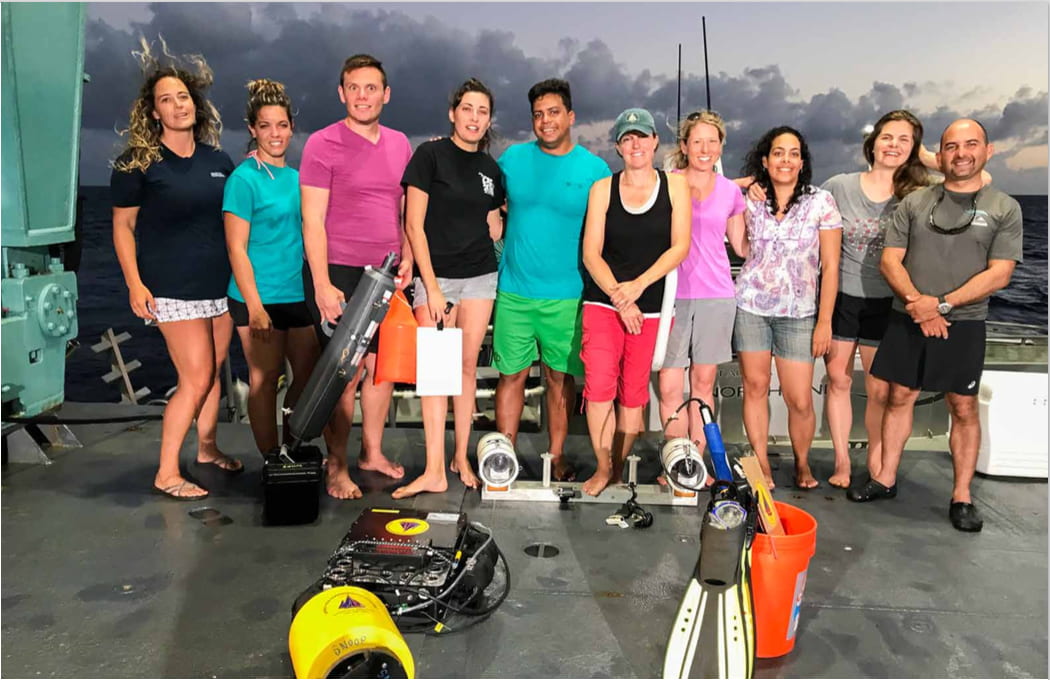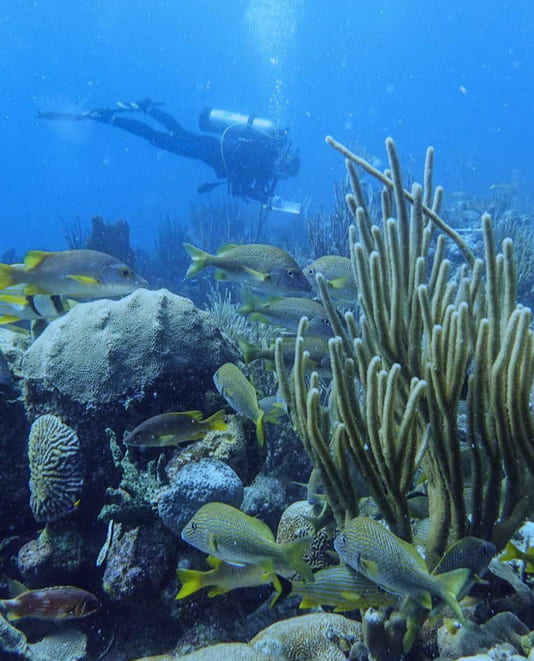Scientists navigate Cuban-US strife through research
By Jane Marks
FALMOUTH, Cape Cod – Laura Weber looks fondly at a gallon-sized tank filled with test tubes and adorned with weathered security clearance forms. This tank, called a dry shipper, had been charged up with liquid nitrogen to act as a special cooler that would keep its contents cold during the long journey from the United States to Cuba and back again.

The shipper made it possible for Weber and a team of New England-based scientists to bring samples of seawater back from Cuba two years ago to be analyzed in the high-tech labs at the Woods Hole Oceanographic Institution in Massachusetts. The journey wasn’t easy, but it was necessary as part of a collaborative study with U.S. and Cuban marine biologists on coral reefs
“TSA does not like the dry shipper as a rule. It looks like it could be a bomb,” said Weber, a graduate student in the MIT-Woods Hole Oceanographic Institution Joint Graduate School Program in Oceanography on Cape Cod. She has focused her research on the different kinds of microorganisms, like bacteria, that live in the seawater surrounding coral reefs. Still analyzing the samples from their most recent trip to Cuba in 2017, Weber is specifically looking at how those microorganisms might be contributing to Cuba’s remarkably healthy reefs.
“For marine science, we share the same oceans. We have to have a way to work together much more easily,” said Amy Apprill, microbiologist and coral researcher at the Woods Hole Oceanographic Institute who led Weber and the rest of the American team to Cuba to research the reefs.
With coral ecosystems collapsing all over the world, Cuba’s thriving reefs make up the largest system in the Caribbean and have intrigued scientists everywhere, including in Massachusetts. The U.S. and the Communist-led island have a historically complicated relationship, but luckily for researchers like Apprill, that has not stopped the sharing of scientific information between the nations, whether it be for marine research or human brain mapping or so many other examples. Though subject to different political agendas, researchers from both countries have found ways to fund projects, conduct field research and share information.
Unlike studying reefs in Florida and the northern-Pacific Ocean, where there is substantial damage from human activities like overfishing and pollution, Cuban reefs offer a unique opportunity for marine biologists.
“I really needed to get to system that was healthy to understand what was normal,” said Apprill, who saw that the Cuban reefs resemble the hustle and bustle of an urban city. “It just feels more active on these healthy reefs.”
However, also unlike studying reefs in the United States, conducting research in Cuba has many more logistical challenges. At the most basic level, it means access to equipment.
With Apprill leading the team from Woods Hole, she knew that the Cuban scientists they would be collaborating with had limited resources. They would need to bring everything including test tubes, the nitrogen charged tanks, lab books and personal diving equipment.
But actually getting to the island is only one aspect of collaborative science between the United States and Cuba. The sharing of science between these two potential rivals can be life saving, meaning that neither one should have sole custody of the information.
“No country has a monopoly on good science,” said Alan Leshner, CEO-Emeritus of the Washington-based American Association for the Advancement of Science where he was the acting CEO for 13 years. Leshner focused on infectious diseases in the U.S. and Cuba, a topic where an open line of communication is of life-saving importance. With only 90 miles of ocean between these two countries, exchanging information on diseases can help monitor and isolate the outbreak to one country, giving the other more time to prepare.
The sharing of science is also important when it comes to preventing illnesses in the first place with vaccines. During an outbreak of meningitis B, Cuba pioneered a revolutionary vaccine for the disease in 1986. However because of the restraints of the political embargo enacted by the United States on Cuba that limits trade with the island, the vaccine wasn’t available in the U.S. for another nine years, said Mark Rasenick, a neuroscientist who worked on science diplomacy with Cuba. With a more collaborative science communication system, that exchange of life saving technology can benefit not only those in the country its developed in, but all over the world.
Seeing the need for an open line of communication for reasons like this, Rasenick and Leshner joined a group of science delegates from the American Association for the Advancement of Science in 2014 to meet with leaders of the Cuban Academy of Science. As a result, the American scientists left Cuba with a signed agreement that would advance scientific cooperation in areas like bioscience research, depression and more.
This helped the work of scientists in many different fields of study, including Rasenick, whose research has focused on neurotransmitter signaling and mood disorders like depression. Through his research, and dedication to science diplomacy, Rasenick has traveled to Cuba more than 25 times over the last two decades to help bridge the gap between the two neighbors with an exchange of scientific findings.
For example, Cuba is among the best in the world when it comes to mapping brain activity and has paved the way for low-cost brain scanning techniques.
“They don’t have the resources we do, so they are much more careful,” said Rasenick. Not having access to advanced devices, Cuban scientists were successful through utilizing mathematical algorithms instead. These are alternatives that could help rural areas in the United States have access to brain imaging as they are cheaper and not reliant on high tech machines that are often only found in bigger cities.
However, scientific collaborations like these struggle with navigating political agendas that have historically complicated the exchange of research. Going back to the time of President George Bush Jr., while scientists were able to travel to Cuba for their research with a general license for travel, it was very difficult for them to bring anything back to the United States. This made it harder to continue any research once U.S. scientists returned home, as they could only rely on samples taken from the field. This is especially true when it comes to marine research like Appill’s that needed the high tech labs at their home base to continue looking at the microscopic organisms and the complex structures of coral cores.
During the Obama administration, the tensions between the two countries eased and allowed for more of an exchange of materials, which included those needed samples. It also made U.S. travel to Cuba easier in general as more tourists were allowed to visit. While this may not have specifically affected the U.S. scientists’ ability in getting to Cuba, it created a positive atmosphere when working with scientists from the island.
However, with the election of Donald Trump, tensions rebounded, with more unease among the scientists on both sides.
“Anytime there are changes in administrations it can impact us or can cause us to pause,” said Katie Thompson, the project manager at CubaMar, a nonprofit based in Miami, Florida, that works to encourage and facilitate collaborative marine research between the U.S., Cuba and Mexico. Luckily though, the non profit is able to avoid government aid as much of possible. “Our work, technically on paper hasn’t been touched,” she said.
As a non-profit not using government funding for projects, CubaMar has been able to continue using funds from private donors for its multitude of marine research projects.
CubaMar’s projects, especially on sea turtles, relies on the working relationship between the countries to not only have collaboration with the scientists on the island, but to also have access to their students. For the sea turtle monitoring project, now on its 17th year, students from the University of Havana were the ones to do most of the ground work. This includes conducting nest surveys and collecting data on both the adult turtles and their eggs. The students have proved themselves integral for this research, as they camp out on the beaches for two weeks at a time during the nesting season (April-October) and walk the beaches to document the turtles.
However, while these students may be able to participate in research here, it would be very difficult for the Cuban students to travel to the U.S. to do the same. American scientists have often been given more leniency for their research trips in the scheme of U.S.-Cuba travel, but science collaboration is not just about scientists from the U.S. to Cuba.
“If you really want to do successful collaboration it should really be a two-way street,” said Rasenick, who believes that scientists from both countries should be able to travel between the two in order to further discoveries in science.

The exchanging of science between the two countries has faced another hurdle with the alleged sonic attacks on the U.S. Embassy in Havana in 2016 and 2017, when American officials were evacuated. As a result, the relationship between the two nations was strained and with it, so was science collaboration. With no U.S. employees at the embassy, Cuban scientists could not get their visas processed to come to the United States. Embassy employees are still slow to make their way back to Cuba, constricting the visa process for people in Cuba further.
“We have to start behaving like we are serious about international cooperation,” said Rasenick who believes that the United States should be making this more of a priority. Rasenick himself attended a meeting at the Cuban Embassy in the United States in February to discuss this issue in the hopes of finding a solution, but little progress has been made.
On the website for the U.S. Embassy in Cuba, there is even a notice posted about how visas to the United States have been almost entirely suspended because of their limited staff. This means that Cuban scientists have a much harder time accessing the U.S., putting all science collaboration between the countries at risk because of a political agenda.
“Science is about finding the truth,” said Rasenick, “not about adhering to a diplomatic whim.”
